Internal energy
1. What is the internal energy of a system and how can it be changed?
Solution:
A thermodynamic system is a collection of microscopic and macroscopic objects forming a whole that can exchange energy with each other or with the surroundings. The total energy of the system is the sum of the total kinetic energy of the disordered motion of particles and the total potential energy of the mutual positions of those particles.
U = Ek + EP
First law of thermodynamics:
The change of the internal energy of the system ΔU equals the sum of the work W done on the system by surrounding bodies acting with forces and the heat Q delivered to the system by the surroundings.
ΔU = W + Q
- a.) The system receives energy (work, heat): W > 0, Q > 0
- b.) The system gives off energy (work, heat): W < 0, Q < 0
Change of internal energy caused by external work: (Q = 0)
Change of internal energy by heat exchange: (W = 0)
Heat capacity:
Specific heat capacity (tables):
Amount of heat received (or given) by a system:
Calorimetric equation (mixing rule):
With calorimeter:
2.English physicist J. P. Joule (1818 – 1889) attempted to determine the specific heat capacity of water. In his experiment he used two weights, each of mass 14 kg, and let them fall 12 times in a row from a height of 2 m into a container with water. The container held water of mass 6.7 kg. During the experiment the temperature of the water increased by 0.24 K. What value of the specific heat capacity of water did he find?
Solution:
Analysis:
2.m1 = 28 kg, Ep =2.m1.g.h = 28kg.10m.s-2.2m = 560 J,
Ek = 12.Ep = 12.560J = 6720 J, m2 = 6,7kg, Δt = 0,24 K
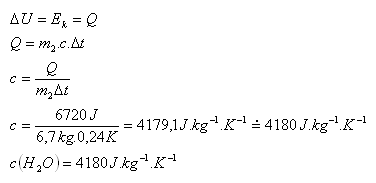
Specific heat capacity of water c(H2O) = 4180 J·kg-1·K-1
3.Think about a short test: If T(K) = t(°C) + 273.15, then which of the statements is true?
Temperature 0oC is
A) –100oK B) 0oK C) 273.15 K
2) Temperature -273.15 is
A) the freezing temperature of helium B) absolute zero C) nonsense
3) Temperature 185.2 oC is
A) –85.2 K B) 458.35 K C) 358.35 K
4) Temperature 0 K is
A) nonsense B) –273.15oC C) 273.150oC
5) A pupil said “The temperature of the water increased by 20oK.” In reality it increased by
A) 20oC B) 293.15oC C) 253.15oC
6) Temperature –1273.15oC is
A) the freezing temperature of hydrogen B) nonsense C) 73.15 K
7) Temperature 290 K is
A) the temperature of a healthy person B) 290oC C) 16.85oC
8) Temperature 373.15 K is
A) boiling temperature of water B) nonsense C ) 0oC
Solution:
1C, 2B, 3B, 4B, 5A, 6B, 7C, 8A
4.A steel rod has heat capacity C = 1.5·103 J·K-1. How will its temperature change if
- a) it absorbs heat Q1= 25·103 J
- b) it gives off heat Q2 = 0.45·106 J
Solution:
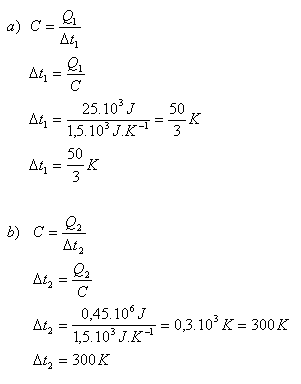
- a) the temperature increases by 50/3 K
- b) the temperature decreases by 300 K.
5.Calculate how long it takes for water to heat from 15oC to the boiling temperature when heated by an immersion heater, if the volume of water is 150 cm3. The heater power is 500 W and its efficiency is 95%. c(H2O) = 4180 J·kg-1·K-1.
Solution:
Analysis:
Δt = 100oC – 15oC = 85oC, V = 150·10-6 m3, Pin = 500 W, η = 0.95
c(H2O) = 4180 J·kg-1·K-1, ρ(H2O) = 103 kg·m-3
Amount of heat received by water:
Time of heating water:
The water heats in just under 2 minutes.
6.To water with mass 2.5 kg and temperature 15oC a steel cylinder of mass 0.9 kg at temperature 300oC was inserted. What will be the final temperature of the water and the cylinder after reaching equilibrium?
Solution:
Analysis:
m1 = 2.5 kg, m2 = 0.9 kg, t1 = 15oC, t2 = 300oC
c1(H2O) = 4180 J·kg-1·K-1, c2(Fe) = 452 J·kg-1·K-1
t = ?
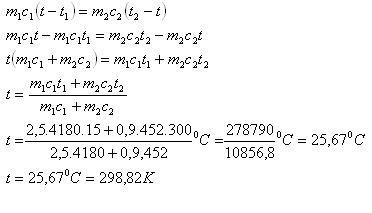
The final temperature of the water and cylinder will be t = 25.67oC.
7.Five steel plates with a total mass of 7 kg were heated to 910oC and immersed into oil at 10oC. How many liters of oil must we use in the quenching bath so that the bath temperature stabilizes at 190oC.
Solution:
Analysis:
Oil: t1 = 10oC, c1 = 1760 J·kg-1·K-1, ρ1 = 940 kg·m-3, m1 = ? V1 = ?
Plates: t2 = 910oC, c2 = 452 J·kg-1·K-1, m2 = 7 kg,
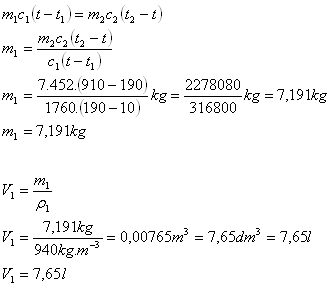
Final temperature t = 190oC
8.There is 0.42 kg of water at 20oC in a container. If we pour another 0.9 kg of water at 70oC into the container, we find that the final temperature after reaching equilibrium is 50oC. What is the heat capacity of the container?
Solution:
Analysis:
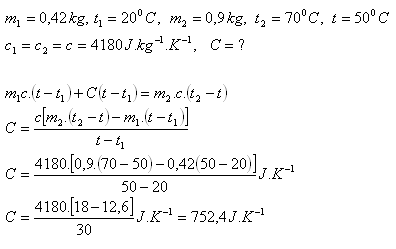
The heat capacity of the container is C = 752.4 J·K-1
9.Into a container with C = 2 J·K-1 was poured water of mass 0.4 kg and temperature 17oC. A cylinder of unknown material with mass 0.124 kg and temperature 64oC was placed into the container. The system temperature equilibrated at 19oC. What material is the cylinder made of? Use tables!
Solution:
Analysis:
Water: m1 = 0.4 kg, t1 = 17oC, c1 = 4180 J·kg-1·K-1 Cylinder: m2 = 0.124 kg, t2 = 64oC, c2 = ?
System temperature: t = 19oC
Container: C = 2 J·K-1
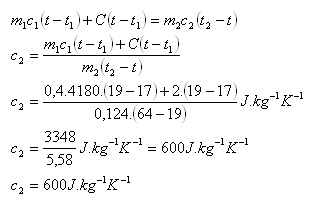
The cylinder is made of brass. (c(brass) = 590 J·kg-1·K-1)
10.When mixing 20 liters of water at 12oC with 40 liters of water at 80oC, 420 kJ of heat escaped into the air. Determine the final temperature of the water!
Solution:
Analysis:
m1 = 20 kg, t1 = 12oC m2 = 40 kg, t2 = 80oC, Q = 420·103 J,
c1 = c2 = c = 4180 J·kg-1·K-1, t = ?
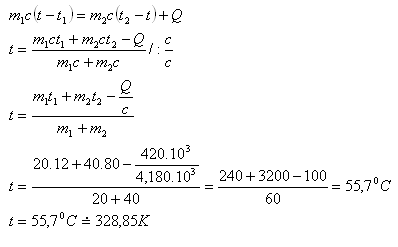
The final temperature of the water will be t = 55.7oC